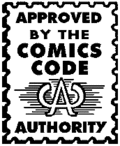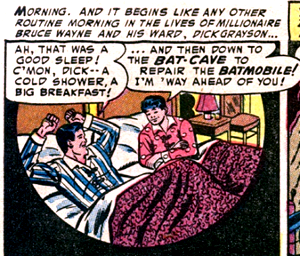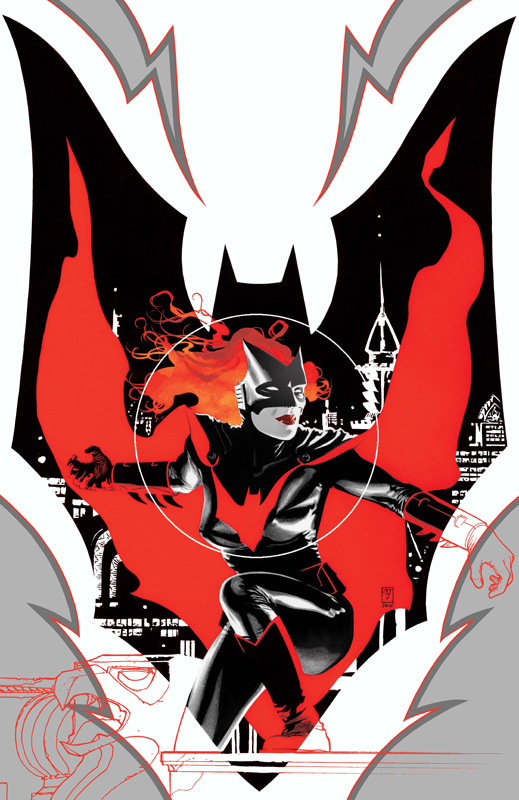There was a time that comic reading wasn’t so readily accepted. Where it was perceived as the territory of children and adult men that the nerd stereotype was born from. As the realm of geek, and comic reading in particular, has become more socially acceptable and even cool, one has to wonder if mainstream comics are keeping up with an expanding and ever more diverse audience.
America is still a nation at odds when it comes to accepting LGBT (Lesbian, Gay, Bisexual, Transsexual) culture. What we do see in the mainstream is often a stereotype or something trying too hard to say “here, we accept you.” It only follows that comics would deal with the same issue and leave some of its readers out in the cold.
LGBT has really had trouble finding its footing in comics outside of indie titles. Homosexuality was banned in mainstream US comics by the Comics Code Authority (CCA) until 1989. It was banned for many of the same reasons that have caused the fight over the legalization of same sex marriage (e.g. intolerance, religious beliefs, lack of understanding). There continues to be a certain element of fear surrounding homosexuality and transgenders.
As noted earlier, there was a time when comics were still largely seen as a media for children, and there were worries that homosexuality in comics would negatively impact developing children. This idea was further cemented by Fredric Wertham’s Seduction of the Innocent, which claimed there were subliminal homosexual tones in titles such as Batman and Wonder Woman.
More recent comics are making the attempt to broaden their character lists to include LGBT characters, but there is still a lot of debate and criticism. A brief Internet search will reveal just how few characters are out there that represent the culture.
For further insight, I turned to C.D. Kirven, a contributing writer at a number of LGBT media outlets including Bilerico, BIENTE magazine, Dallas Voice, Bay Windows, Dallas Post Tribune, and more. She is also an activist in the community and an avid comic fan.
COMIC ATTACK: Of the few LGBT characters in mainstream comics, how many do you think are realistic and positive portrayals?
C.D. KIRVEN: I believe there is a lot of work that needs to be done to achieve more realistic and accurate portrayals of LGBT characters in mainstream comic books. I do believe there has been a small amount of progress made with the introduction of Batwoman as a lipstick lesbian and the new gay Archie character. There is a desperate need for more comic book superheroes of color, bisexuality, and transgender identified characters. In 2002, DC Comics touched briefly on the controversial subject of gay bashing. Green Lantern’s gay teen friend, Terry Berg, was brutally attacked by thugs. (Today’s “It Gets Better” campaign could use some “superhero” support with the recent increase in LGBT teen suicides.) Unfortunately, nothing was done to develop the Terry Berg character so that brief opportunity turned into a footnote in DC Comic’s history. In 2005, the young Avengers characters Huckling and Wiccan were protrayed somewhat accurately by gay writer Alan Heinberg. He allowed them to simply be two young superpowered boys in love.
CA: What character do you think has been the best portrayal overall?
CDK: I don’t believe we’ve had any fully developed LGBT characters in mainstream comics. Like most media, intolerance is a universally accepted practice. In television, film, music, and news reporting – LGBT subject matter is often neglected due to religious opposition. This allows superficial stereotypes to become the face of our community. This is extremely unfortunate because I believe everyone has an LGBT person in their lives. We have families and children. The omission of well developed LGBT characters gives misrepresentations and homophobia more legitimacy. There is a real opportunity in comics to introduce well rounded LGBT characters into the mainstream consciousness. Most people use comics as a form of escape, so to have more diverse representation would allow comics to lead the way by representing the diversity that actually exists in our society.
CA: Do you think there is a good balance of gay and lesbian relationships?
CDK: No. I believe there are some relationships that could be fully developed like Huckling and Wiccan, but there is an extreme fear of consumer backlash. Comic book distributors fear comic book loyalist will reject realistic intimacy between LGBT characters. Most of this fear is generated from situations experienced by companies like Microsoft and their XBOX Live when LGBT gamers were called homophobic slurs and rejected openly within their online gaming communities. Microsoft intially attempted to address the issue by changing it’s policy prohibiting any gamer from expressing their sexual orientation. This soon was met by nationwide opposition and now Microsoft allows gamers limited sexual orientation identification. But if we allow fear to control our creativity then freedom of expression is only an ideal which limits a world of possibilities. I don’t want to live in a world where everyone is the same and ignorance is bliss. What message is that sending to our youth about tolerance?
CA: In what ways do you think comic creators could improve characters that are LGBT?
CDK: I think it starts with hiring more LGBT artists, writers, and more artists of color. They bring unique experiences and perspectives to their work. I’m sure this approach can be validated by the success of Boondocks on Adult Swim. Comic book publishers have a real opportunity with the recent growth in the digital market to experiment with a more diverse range of characters. Tyler Perry recently proved there was a market for black films, which Eddie Murphey also proved several years ago. The new gay Archie comic book sold out quickly and there has been an increase in sales of LGBT teen fiction. There is a market for these stories that have been closeted for way too long. I would like to see DC or Marvel Comics publish LGBT work instead of most LGBT comic books being self-published locally and not given an opportunity to find any major market success.
CA: There was a lot of buzz and controversy a while back about Batwoman being revealed as a lesbian character. What is your take on the debate?
CDK: I was on the celebrating end of the debate having experienced years of no LGBT representation. Most of the feedback from my side was positive and the debate, I believe, was good publicity for the revamped Batwoman. I believe enough time has passed to acknowledge and reveal that a lesbian Batwoman was a positive move by DC Comics. I hope the creators will allow this character to have a wide range of experiences so that everyone will see lesbians are like everyone else. But, you have great people like Megan Fox, who recently declared she wanted to play Sarah Rainmaker, a lesbian Native American superhero, from the Gen 13 comic books. Those kind of films need to be made and will make a huge difference in the public’s perception of the LGBT community.
CA: How do you feel about the backlash from comic readers that are made uncomfortable by LGBT themes in comic books?
CDK: I was broken hearted as a comic book lover myself. I was raised on the Christopher Reeves Superman films and the movie The Last Dragon. It’s hard to tell a teen it gets better when hatred is staring you in the face. I’m often put off by the overt homophobia and most other LGBT comic book consumers feel the same way. If we aren’t tolerated in fantasy then what are the chances that actual laws will be passed that are critical in improving our everyday lives. There are some real LGBT heroes that were soldiers who sacrificed their lives for our country in silence. You are left with no where to run from the inhumane cruelty expressed in our comic book reality. The LGBT community is left waiting for Superman to have a more humane face. I don’t expect acceptance but I will always hope for tolerance. Our perception is our reality, so if there are no LGBT characters or superheroes, then we don’t exist. It’s that simple, and we need to broaden the comic book audience because personally I would love to see more comic book films.
CA: Some comics that portray gay and lesbian superheroes have been required to be labeled as “adult.” What are your thoughts on this?
CDK: It’s very harmful because I feel it validates the homophobic claims of a small group of people that believe there will be some kind of harm caused by positive LGBT images. In fact, Curve magazine (which is the lesbian version of Cosmo), is mailed in black plastic. It’s very embarrassing because once you open the magazine everyone sees there is no adult content. It baffles me that we have real adult content on regular television or HBO unlabeled but we are required to label LGBT comics “adult content” because the characters are gay. It validates the kung-fu grip religion has on the freedoms of LGBT expression.
CA: Is there anything else you would like to say on the topic of LGBT in comics?
CDK: I know it’s hard but some of us will have to lead the way. I’ve created the TAO Diaries, and my lead character is the first black out-lesbian superhero. Self-publishing is easier now with companies like Comic Island or Ka-Blam print-on-demand services. Also, we need allies to support LGBT characters and buy LGBT comic books. We need more mainstream comic book websites and Comic Cons to give self-published LGBT creators a platform to promote their work. I would like to see someone like Frank Miller mentor an LGBT comic book artist. If there is any LGBT youth reading this article, dream big and know anything is possible. You could be the one to create the first nationally accepted gay superhero, and don’t let the ignorance of a few stop you from living out your dreams. The United Kingdom and other countries have leaped ahead of America in more diverse comic book representation and this is heartbreaking because we are the beacon of the world. I know in my heart the world is big enough for all types of people and beliefs, but to open up the fantasy world of comic books to the possibility of LGBT acceptance will change the world in a very positive way. Any real change starts and ends with you. Thank you to Comic Attack for addressing the topic of LGBT comic books.
You can find out more about C.D. Kirven at her site.
Macabri
mac@comicattack.net
@Macabri








Good interview, Mac.
It’s worth bringing up that African Americans experienced the same sorts of prejudices, including religious prejudice. It took a long time for them to get basic human rights, and it will probably take a long time for the LGBT group too. Which is the issue in my mind. Whether you agree with the lifestyle or not, all humans deserve basic HUMAN RIGHTS. Period. To treat them as less than human (which is what is happening) is incredibly degrading and beyond inexcusable.
Manga has similar issues as American comics, which is funny, as there are entire genres devoted to it. Yaoi – boys’ love, and yuri – girls’ love. Yaoi is a huge publishing force, and even has sub genres (books about boys written by women for women, and books about men written by men for men). But very few yaoi books (specifically the ones by women for women) have self-proclaimed gay characters, or even represent them properly. Most of the time it’s straight guys who just fall in love with each other. The other subset, written by men for gay men, is less prominent, and rarely (if ever) even gets published in America, but certainly has the right perspective going for it.
Unfortunately, the smallest minority has the loudest voices.
By the way, lesbian Batwoman was great. Wasn’t she going out with The Question (Montoya I think her name was) at some point around 52? Colossus was gay in Ultimate X-Men, which was a hit with fans, from what I remember.
Thanks Kristin!
It’s definitely a widespread problem across comics in general; from mainstream to manga. I think there’s support for a forward change, but change is always slow.
Pingback: Tweets that mention LGBT in Mainstream Comics, or the Lack Thereof -- Topsy.com
Pingback: LGBT in Mainstream Comics, or the Lack Thereof - Strange Like That
I think the real issue is flat characters based around singular traits or plot points as illustrated by the Green Lantern example above. We don’t get a person who lives these lifestyles, we get Gay Guy #3 or Lesbian #2. The problem doesn’t go away until characters are no longer typified by their ‘differences.’
I have to argue the reasoning behind the need for more LGBT creators though. Yes, they have as much right to a job as anyone, successful gay creators like Phil Jimenez working in superhero comics now show that. What about all the other creators though? If we need more LGBT creators in order to fix LGBT characters, does that mean any other creator is incapable or can’t be educated?
Northstar from X-Men? Apollo and Midnighter from Stormwatch/The Authority?
I guess it depends how you define “mainstream”.
Also Rictor and Shatterstar from X-Factor and Ultimate Colossus and Ultimate Nightcrawler come to mind. But I wouldn’t chalk them up as mainstream either. I think Marvel handles this issue far better than the other publishers. DC is making strides with Batwoman though. She’s awesome.
Jade – I think that other non-LGBT comic creators are capable of creating compelling and accurate characters, but more diversity wouldn’t be a bad thing either. As always, it’s all about having a good mix.
Pingback: comic attack interviews c. d. kirven « gender panic
Awesome article!
Just read Kevin Smith’s Green Hornet #10 from Dynamite. Add the new lady Kato to the list!
Still though, I’m not sure I’d call this series “mainstream.”
Pingback: Lesbian Artist & Activist, C.D. Kirven | Card Carrying Lesbian ... What's in your wallet?